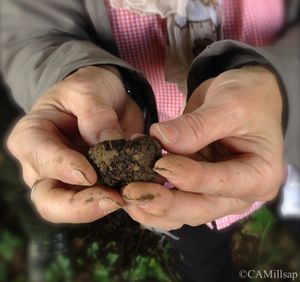Travel: Truffle Hunting in Croatia
Our small group, an assortment of travelers from the US, Canada and Germany, gathered as Ivan Karlic, our guide, leashed up Blackie, the sweet, specially trained dog who would sniff out truffles buried at the base of oak trees growing in a small grove on a hillside near the village of Buzet. Most of us were visiting the Istrian peninsula of Croatia for the first time and none of us had ever been on a truffle hunt.
Blackie knew what to do. Nose to the ground, she set out snuffling at the thick layer of leaves on the forest floor. Tail wagging, she moved quickly from one spot to another while Ivan whispered soft words of encouragement. We followed them both, stepping over roots and stones.
Pigs were once the traditional truffle hunting animals, but as Ivan pointed out, it’s much easier to stop a dog from destroying or eating the truffle than a determined pig. So, these days, most truffle hunters have made the switch.
Truffles are true buried treasure. Black truffles, the ones we were watching Blackie search for, average 30 to 50 Euros. When they’re in season, white truffles can go for many times that amount. That’s no small thing when you consider most are the size of a walnut or a small apple.
As we walked behind Blackie, Ivan chatted with us about his family’s business harvesting the truffles from the small wood. But suddenly he called out to the dog and rushed over to pull her away from where she was pawing at the ground. Using the tool he carried, a flat blade attached to a stick, he sliced into the dirt until the truffle was exposed. Gently, he scraped the dark soil away with his finger until he could gingerly pry the truffle free of the root to which it had been attached. He held up the prize and we cheered. Blackie got a treat for a job well done.
While we were still admiring the find, Blackie went back to work. Once again we followed her zigzag path, talking quietly as we watched her stop, sniff, sniff again and then move on. When she started pawing at the ground, Ivan ran over to her and again, pulled a hard black truffle from the ground. Blackie moved deeper into the small forest and a few minutes later she hit paydirt again. While Ivan worked to free that truffle the dog started scratching at the base of another tree nearby. He called out for someone to help so I took his place and slipped my fingers into the hole he’d created with his spade. The dirt was cool and moist as I worked it away from the truffle. Like an archaeologist, I worked slowly, gently, scraping away the soil that concealed the truffle until Ivan came back and helped me pull it away from the root. I handed my phone to the woman beside me and asked her to take a photo. In the image, I am a blur. The only thing in focus are my hands, muddy, with dirt-caked fingernails cradling the truffle. It was exactly right.
We carried the four truffles we’d gathered back to the farmhouse and Ivan’s mother, Radmila, met us at the covered patio. She exclaimed when she saw what we’d found. Apparently, it was a very good truffle hunt. Blackie, after being petted again by everyone in the group, was taken back to the kennel with the family’s other truffle-hunting dogs.
Radmila broke eggs into a bowl, added thin slices of one of the truffles we’d found and made an omelet of our work.
She sliced a baguette and topped the slices with butter and another sliver of truffle on top. With savory sausages and bottles of house-made wine, we had a meal so fragrant and delicious I will remember it forever.
I’d expected the tourist treatment: a field “salted” with truffles that had been planted so we could have the (artificial) pleasure of watching a dog sniff them out. But my experience was just the opposite. I kept the photo and I’m going to frame it for my kitchen. The next time I make an omelet, I’ll think of that day; the feel of the dirt on my fingers and the unmistakable earthy fragrance of delicious buried treasure.
Cheryl-Anne Millsap is a travel writer whose audio essays can be heard on Spokane Public Radio and on public radio stations across the country. She is the author of ‘Home Planet: A Life in Four Seasons’ and can be reached at catmillsap@gmail.com
